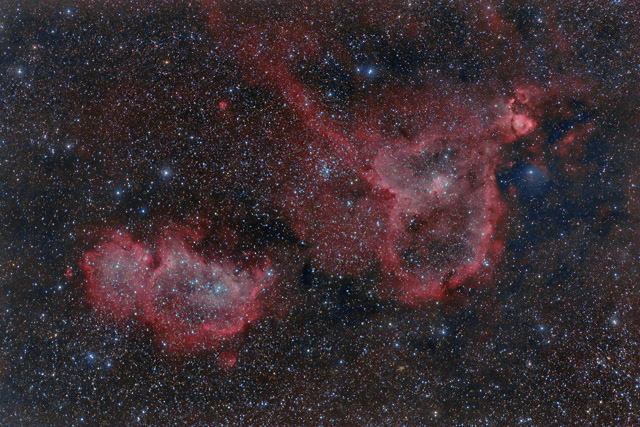The Heart and Soul Nebulae in HaRGB
|

|
The Heart Nebula (IC 1805) and the Soul Nebula (IC 1848) are two giant molecular clouds located in the constellation of Cassiopeia. The two clouds are physically connected by a bridge of gas and reside in the Perseus arm of our Milky Way Galaxy. In the center of the Heart Nebula is the open cluster Melotte 15, which is one of many clusters formed from the molecular cloud. These clusters within the clouds are known as the Cas OB6 association, and the energy from their hot stars illuminate the surrounding nebulae. This photo is a composite of a Hydrogen Alpha version of the image with an RGB (color) version.
In this image, North is up.
| Exposure Details |
| Lens |
Canon EF 200mm f/2.8L II USM |
| Focal Length |
200mm |
| Focal Ratio |
f/3.5 |
| |
| Mount |
Schaefer GEM - 7 1/2 inch Byers gear |
| Guiding |
Piggybacked on C8, guided with an ONAG On-Axis Guider, Lodestar autoguider, PHD Guiding |
| |
| Camera |
Canon 450D - Gary Honis modified (Baader Mod) |
| Exposure |
106 subexposures of 600 sec @ ISO 1600 (17 2/3 hours) using Astronomik 6nm Ha clip filter plus 57 subexposures of 300 sec @ ISO 400 (4 3/4 hours) |
| Calibration |
30 darks, 30 flats, 30 flat darks, 30 bias |
| |
| Date |
September 11, 12, 13, and 14 2013 |
| Temperature |
60F on 9/12, 62F on 9/13, 64F on 9/14 |
| SQM Reading |
21.45 (Bortle 4) on 9/12, 20.0 to 21.5 on (Bortle 5 to 4) on 9/12 and 9/13, 19.50 to 21.50 (Bortle 5 to 4) on 9/14 |
| Seeing |
5/5 on all 4 nights |
| Location |
Pine Mountain Club, California |
| |
| Software Used |
Images Plus 5.5 for camera control, calibration, stacking, digital development, smoothing and noise reduction, multiresolution sharpening, and star size and halo reduction. Photoshop CS5 used for levels and curves, high pass filter, star shrinking, screen mask invert, lab color, match color, vibrance, selective color, hue adjustments, and unsharp mask. Gradient Xterminator for gradient removal. Registar for registration and stack alignment. Carboni Tools for additional noise reduction and smoothing. |
| Notes |
I still haven't figured out all of the nuances of combining Ha and RGB, so I wasn't able to bring out as much of the Ha in this composite as I wanted to. I think the overall color is pretty good, and I avoided an overly red bias to the HaRGB combination as well as the salmon color that can result from an overly aggressive application of Ha. Someday after I refine my techniques, I hope to recombine this image and improve upon it.
This image was published in the Winter 2014 issue of Amateur Astronomy Magazine in my article entitled "DSLR Wide Field Imaging with Narrowband Filters:High Quality Images, Even from Light Polluted Locations". |
|
|